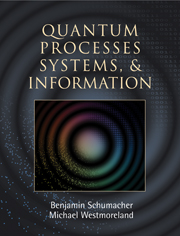Book contents
- Frontmatter
- Contents
- Preface
- 1 Bits and quanta
- 2 Qubits
- 3 States and observables
- 4 Distinguishability and information
- 5 Quantum dynamics
- 6 Entanglement
- 7 Information and ebits
- 8 Density operators
- 9 Open systems
- 10 A particle in space
- 11 Dynamics of a free particle
- 12 Spin and rotation
- 13 Ladder systems
- 14 Many particles
- 15 Stationary states in 1-D
- 16 Bound states in 3-D
- 17 Perturbation theory
- 18 Quantum information processing
- 19 Classical and quantum entropy
- 20 Error correction
- Appendix A Probability
- Appendix B Fourier facts
- Appendix C Gaussian functions
- Appendix D Generalized evolution
- Index
3 - States and observables
Published online by Cambridge University Press: 05 June 2012
- Frontmatter
- Contents
- Preface
- 1 Bits and quanta
- 2 Qubits
- 3 States and observables
- 4 Distinguishability and information
- 5 Quantum dynamics
- 6 Entanglement
- 7 Information and ebits
- 8 Density operators
- 9 Open systems
- 10 A particle in space
- 11 Dynamics of a free particle
- 12 Spin and rotation
- 13 Ladder systems
- 14 Many particles
- 15 Stationary states in 1-D
- 16 Bound states in 3-D
- 17 Perturbation theory
- 18 Quantum information processing
- 19 Classical and quantum entropy
- 20 Error correction
- Appendix A Probability
- Appendix B Fourier facts
- Appendix C Gaussian functions
- Appendix D Generalized evolution
- Index
Summary
Hilbert space
The prototype qubit systems of the last chapter are very simple, but they can be generalized to more complicated versions. We can send a photon through an interferometer with three, four or more distinct beams. We can perform experiments on particles with higher intrinsic angular momentum than the spin-½ particles we have discussed. And we can analyze atomic systems in situations that involve more than two different energy levels. For these cases and others, we will need a more general version of quantum theory.
That theory will include two pieces. First, we will have a general mathematical structure that is applicable to many kinds of system. Here the qubit case will be our guide, since many of the basic concepts for other quantum systems are already present in the qubit case. Second, we will have to describe how to apply the quantum formalism to specific physical situations. Though the quantum systems we discuss will appear quite various, they share strong family resemblances that are expressed in the common mathematical framework. Keeping the framework in mind will help us understand specific examples; keeping the examples in mind will help us understand the framework.
The states of a quantum system are described by kets |ψ〉, which obey the principle of superposition. This means that the kets are elements of an abstract vector space ℋ called a Hilbert space.
- Type
- Chapter
- Information
- Quantum Processes Systems, and Information , pp. 47 - 78Publisher: Cambridge University PressPrint publication year: 2010



